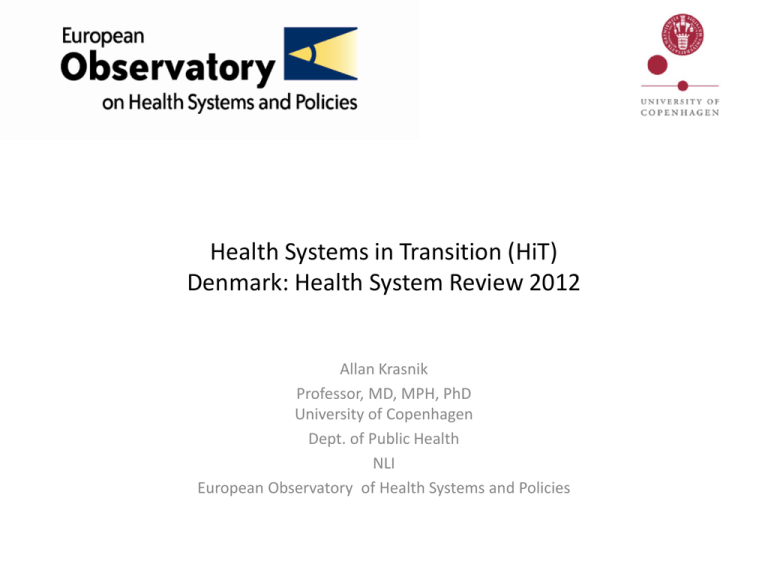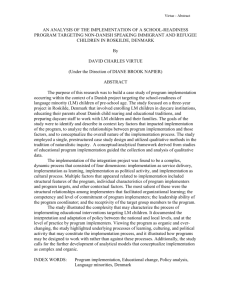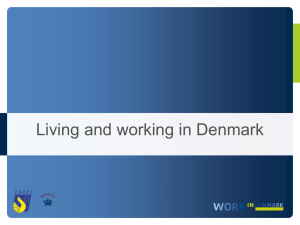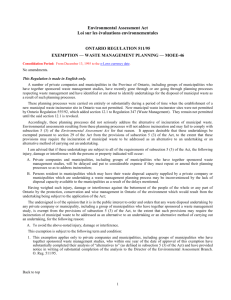Health Systems and Policy Analysis
advertisement

Health Systems in Transition (HiT) Denmark: Health System Review 2012 Allan Krasnik Professor, MD, MPH, PhD University of Copenhagen Dept. of Public Health NLI European Observatory of Health Systems and Policies Analysing Health Systems and Policies www.healthobservatory.eu The Observatory WHO? An Effective Partnership The European Observatory is a three-way partnership building bridges both across borders and between policy makers and researchers. International Agencies National and Regional Authorities • WHO Europe (host) • Belgium ● • European Commission • Finland ● Spain • Slovenia ● Sweden • European Investment Bank • World Bank Norway • Netherlands • French Union of Health Insurance Funds • Veneto Region of Italy Academia • London School of Economics and Political Science (LSE) • London School of Hygiene & Tropical Medicine (LSHTM) A Knowledge Broker The European Observatory is a high-quality knowledge broker based on following principles: Transfer Trust Bridge between policymakers and researchers: information users and producers High-quality evidence and a neutral stance recognising the real context and pressures of health systems Tailored Timeliness To the specific needs of policy makers Of response to policy maker’s needs and requests What and How? Comparative analysis Bridge of existing evidence Between policymakers and researchers Developing practical lessons and options in health policy-making Core Mission: The European Observatory supports and promotes evidence-based health policy-making Comparative Analysis: Tools Vertical: Country Monitoring (HiTs) Horizontal: Health Systems and Policy Analysis Describing national health systems Detailed focus on one topic across national health systems Common template for direct comparison 53 European + selected OECD countries Secondary research Practical Lessons and Options: Tools Assessing and Comparing Performance Provides better understanding of uses and abuses of comparative performance data Creates a toolbox for better measurement and analysis Engaging Policymakers Two channels: policy briefs and face-to-face policy dialogues Tailor-made, focussed on one specific issue Bring together evidence, assess options and formulate implementation roadmaps Summary Who A partnership of international agencies, national and regional authorities and academic institutions, hosted by WHO/Europe What Supporting and promoting evidence-based health policy-making How Carrying out comprehensive and rigorous analysis of the dynamics of health systems in Europe • Country Monitoring • Health systems and policy analysis • Assessing and comparing performance • Disseminating evidence / engaging with policy-makers University of Copenhagen Dept. of Public Health Unit for Health Services Research The Nordic model? • General entitlement • Mainly tax financed • Mainly public hospital providers • Mainly decentralized governance • GPs in a key role But also many differences! Life expectancy in selected countries Health expenditure as a share of GDP Financing Danish health care • More than 80% of the total health care expenditure is financed by taxes • The role of out-of-pocket payments differs markedly by service • VHI financed by employers has increased dramatically since 2001 • VHI still only finances about 1.7% of total hospital services in Denmark[ • The five regions are financed through block grants as well as activity-based financing from the municipalities and the state • The 98 municipalities are financed through income taxes and block grants from the state + intermunicipal transfers Stepwise reforms ??????? of Danish health care Afdeling for Sundhedstjenesteforskning Structural reform 2007 From 274 to 98 municipalities From 14 counties to 5 regions Health service delivery – a fragmented organization • Municipalities are responsible for disease prevention, health promotion, care and rehabilitation performed outside hospitals • Primary care consists of private (self-employed) practitioners (GPs, specialists, physiotherapists, dentists, chiropractors and pharmacists) and municipal health services • GPs act as gatekeepers, referring patients to hospital and specialist treatment. • Most secondary and highly specialized care takes place in general hospitals owned and operated by the regions The patient perspective: Access to health services Pathways for gynecological patients Municipal rehabilitation Can GPs cope with the future challenges? Major policy themes • Free choice • Waiting time • Quality of care – Survival – Continuity – Prevention Free choice and waiting time 1993 2002 2005 2007 2009 Free choice of hospitals Extended free choice (2 months) The new comprehensive Health Act Waiting time guarantee 1 month Waiting time guarantee and extended free choice for child and adolescent psychiatry (2 months) 2010 + Adult psychiatry Health care services: The pride of Danish welfare society? Quality issues: 30 days mortality after acute myocardial infarction (%) Quality issues: Cancer survival Survival from lung cancer (%) Denmark Denmark Solving problems of continuity of care? • Health agreements – Regions and municipalities – National Board of Health – GPs? • GP coordinator fee • Other incentives required • Clinical pathways – Cancer – Heart disease • IT innovations – The EMR – The Medcom project: Danish online health portal – The Shared Medication Record – The sentinel data capture system Quality issues: Prevention and rehabilitation The new municipal responsibilities – a difficult task! Local governance – local autonomy – soft national measures Issues of • Organization • Evidence • Competences • Resources • Political priority på forskellig vis. Samtidig vil sundhedsfremme og forebyggelse ofte være en integreretSted og dato Enhedens navn del af de kommunale kerneopgaver på fx børne- og ældreområdet. Således kan de opgjorte udgifter ikke tages som udtryk for, hvor mange ressourcer kommunerne anvender på sundhedsfremme og forebyggelse. Municipal expenses for health promotion and prevention Figur 2.1. Nettodriftsudgifter til sundhedsfremme og forebyggelse Kilde: Danmarks Statistik Anm: Tal fra 2008. Både konteringen, organiseringen og afgrænsningen af forebyggelse og sundhedsfremme kan variere fra kommune til kommune. Det giver en vis usikkerhed i tallene. Enhedens navn Sted og dato Municipal rehabilitation plans per 1,000 inhabitants Conclusions • The health status of the Danish population is improving, but still relatively unfavorable • The public health service provision and tax based financing is still strongly supported • The decentralized organization is under pressure • Quality and continuity of care are major issues • IT support and communication is a main focus area – it is necessary, but not sufficient • More major reforms can be expected in order to meet future challenges Evolution or revolution? “It is raining too much in Denmark for revolutions!”











